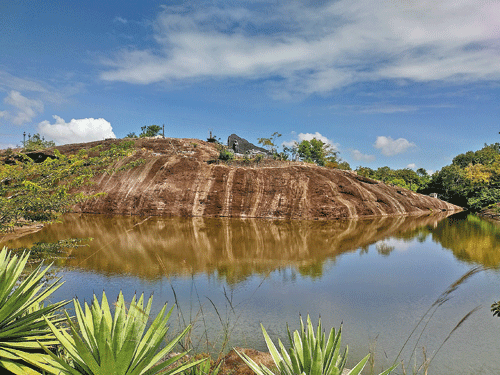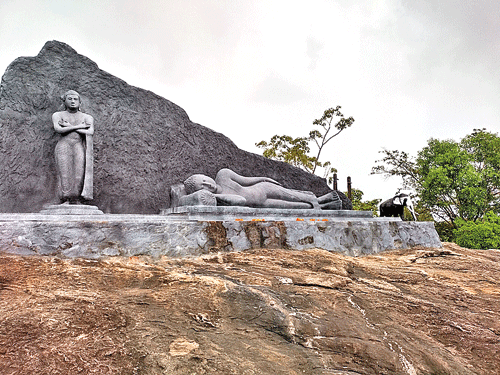Enjoying Buddhangala – past and present

Tranquil landscape: Rock and water. Pix by Pamal Yapa
In Digamadulla or modern-day Ampara, there is no dearth of ancient shrines, many taken over by jungle tide, with giant sleeping Buddhas in caves, unidentified stupas and unread inscriptions and legends on rock and pillar.
The Buddhangala forest monastery however, has been revived from that state when leopard and bear used to roam the drip-ledged caves and is now once again the home of saffron-clad forest monks as it was an ancient sanctuary for the Arhants.
We drove there, deeply grateful for the forest shade that engulfed the road running from Ampara like a dark soothing tunnel; we were within the arboreal shadow of the 5700-acre wildlife sanctuary the monastery grounds have today become.
The history of this monastery goes back to the 2nd Century BC when a princess of Digamadulla called Chitra donated the land, amply suited to a forest monastery, with solitary rock caves on high ground commanding panoramas of the jungle and plateau.
We walked up. Here we found the modern and the kitsch unfortunately cheek by jowl with all that is ancient and beautiful. It is sad that ornamentation should destroy the serenity of rock and forest and sky.
That apart, you can enjoy the place for what it is and what it once was. The stupa is located on a rock which gives you a breathtaking panorama of Digamadulla and beyond, up to the sea – with its variegated map of archaeological sites and pilgrim shrines.
 The abundance of ‘moonstones’, steps and korawakgal (balustrades) of stone strewn about, allows the visitor to imagine the erstwhile splendour of the place.
The abundance of ‘moonstones’, steps and korawakgal (balustrades) of stone strewn about, allows the visitor to imagine the erstwhile splendour of the place.
On the rock plateau is a pond, and here one sees ruins of a janthaghara or a bath house.
A modern giant Buddha in white dominates the skyline.
All this however was deep wilderness when in 1964, the pioneering monk Kalutara Dhammananda came here and revived what was originally a monastery centuries back. Monks had last lived here prior to the disastrous medieval invasion of Kalinga Magha- i.e. in the early 13th Century.
Among the archaeological treasures discovered in the wake of the intrepid Ven Dhammananda was a very rare round siripathul gal or stone depicting the Buddha’s sacred footprints. While square siripathulgal are quite common, these are unique in the island.
The ancient watada-ge or the relic chamber under excavation yielded a king’s ransom of artefacts, amongst which was a four-inch gold casket which once opened revealed three lotuses. The tallest gold lotus, the one in the middle, is said to have contained three relics of the Buddha while the other too had relics of his two chief disciples Sariputta and Mugalan.
While Buddhangala has not many archaeological curiosities, just a walk through its landscapes of forest and rock undulating as one great gal thalaawa is soothing to the soul.
Much of of Buddhangala’s past remains elusive. The modern name comes from the rock shaped like a giant reclining Buddha but what would have been its ancient identity? Was this the Karakdigala monastery recorded of yore?
The jungle tide in Digamadulla has much yet to divulge.
Searching for an ideal partner? Find your soul mate on Hitad.lk, Sri Lanka's favourite marriage proposals page. With Hitad.lk matrimonial advertisements you have access to thousands of ads from potential suitors who are looking for someone just like you.


